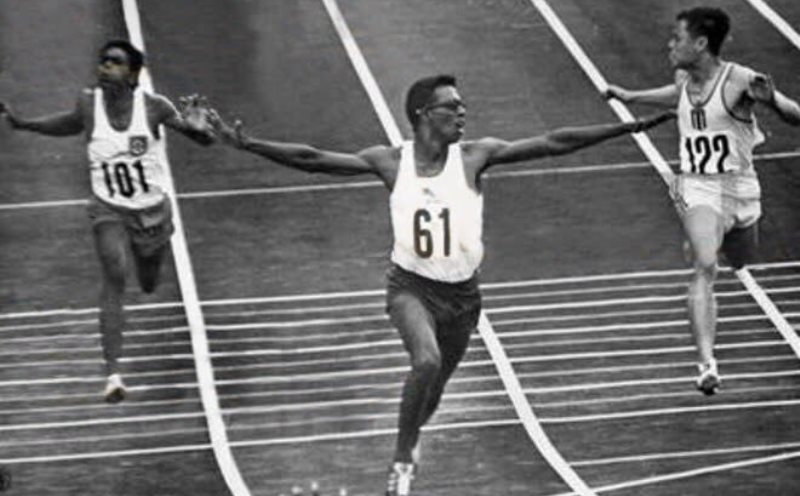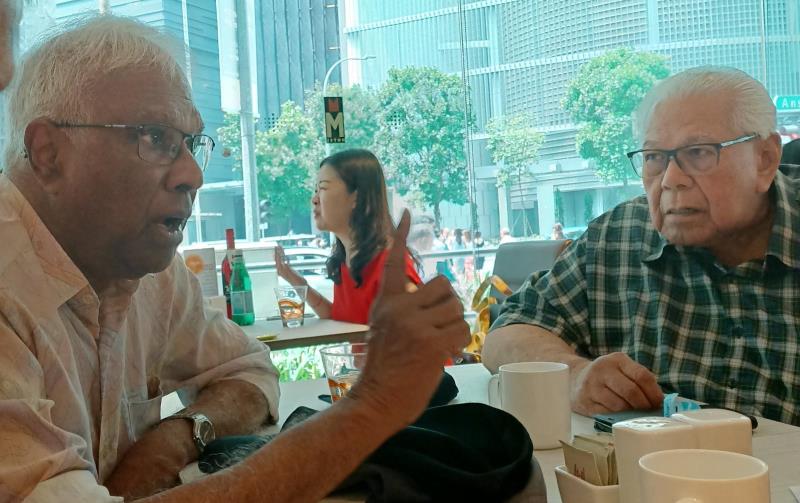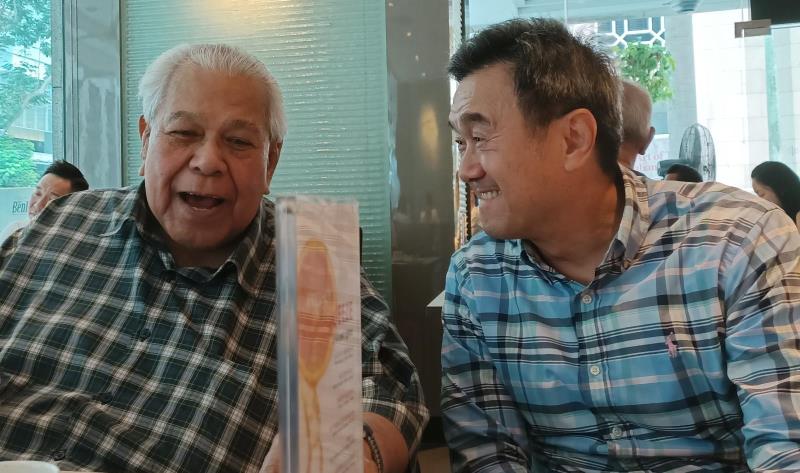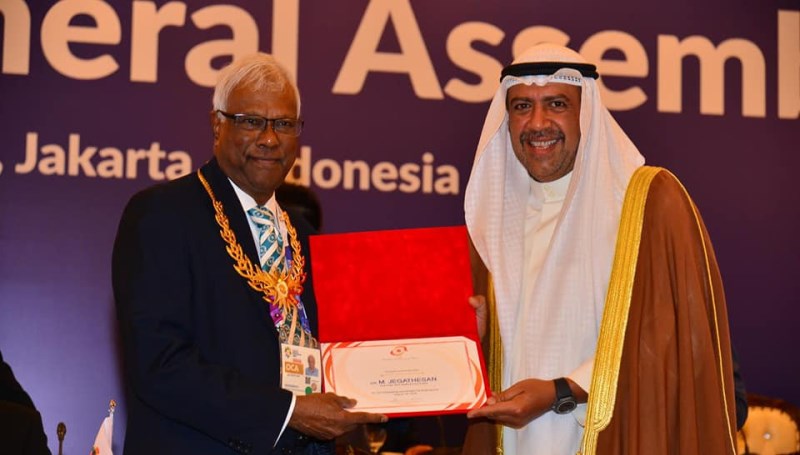
I must admit at the starting blocks that I was in pampers and scampering on my fours when these six legendary sprinting wizards hounded the grass and bitumen tracks at Jalan Besar Stadium and Farrer Park in Singapore and even multiple stadiums in Asean and Asia.
Now they’re in their 70s, some nearing 80s, and on Tuesday lunch at The M Hotel along Anson Road, as a journalist, I watched in admiration as they gamely exchanged notes and talked about the glorious track era, half-a-century ago, where they ran passionately for national glory and never ever for monetary incentives.
Those were the good ‘ole track and field days when Singapore’s fastest track sprinters of the 1950s and 60s blazed the tracks and even ventured to the sprinting blocks at the Olympic Games.
Their elite names just roll off like legends of an extraordinary “Golden Oldies” era: From Asia’s fastest man, Tan Sri Dr Mani Jegathesan, 76, hailed as “The Flying Doctor” who ran the 1960 (Rome), 1964 (Tokyo) and 1968 (Mexico City) Olympic Games; Lieutenant-Colonel (Retired) Kesavan Soon, 80, at 17-year-old, the youngest schoolboy to partake in the 1956 Melbourne Olympic Games; Singapore Airlines pilot Low Sin Chock who was the 1963 record-holder over 100m (10.8sec) and 200m (21.8sec); Educationist Cedric Monteiro, 81, national sprint record holder in the 1960s; Prisons senior officer Loh Chan Pew, 74, who won a 4x100m relay silver at the 1973 SEAP (South-East Asian Peninsular) Games and business magnate Tang Weng Fei, 65, sprint hurdler, who is now President of Singapore Athletics (SA).
As a 64-year-old journalist listening to the extraordinary lifestyle tales of the six stalwarts, I realised that marathon, as in life, performs best for those who pace themselves. Life and marathons are not sprints. They say get back up on that proverbial horse; what really matters though is that you cross the finish line, even with the horse in tow. In the final context, determination and drive prevail over speed.
DISTINGUISHED SPRINTERS
Much as they’re distinguished sprinters, they had one message in common and kept promoting the idea that you didn’t have to be fast – all you need to do is finish what you start in life, or in a marathon. Indeed, distance isn’t overcome by speed, but rather by determination and drive.
Even after they hung up their spikes, they knew that as much as they had to pursue their professional careers to support their respective families, they also had to give back, and to encourage the younger sporting generation to be world-class athletes by sharing their ideas of a past generation to show that there’s a future in regional track and field.
I was just overawed, if not impressed, by Jegathesan, who blazed the tracks around Asia despite being a doctor. He was an icon in the 1960s, regarded as the “Golden Era” of Malaysian athletics. In his heyday, he was regarded as the “fastest man in Asia”, winning three gold medals at the 1966 Bangkok Asian Games in the 100m, 200m and 4 × 100m relay events.

JEGA: ROLE MODEL
A role-model extraordinaire, he showed that sports and academics can nicely mix with his outstanding career as a renowned doctor and researcher-scientist in medical microbiology, infectious diseases and tropical medicine. The record books show that he remains till today as one of the greatest athletes in the history of Malaysian and Asian sports.
In my opinion, his nickname as the “Flying Doctor” was God-send as his speed, great strides and style on the track was an inspiration to the youths during that time. From childhood, Jegathesan showed the passion for athletics which continued to be an important moving force of his life.
To begin with, according to Jegathesan, only in 1924 athletics was opened to the others in Malaya, before that it was only for the whites. His father, Manikavasagam, was the first non-European who competed and won the 440 yards in the Malayan Open Championship. His dad together with his friends in 1953 formed the Federation of Malaya Athletics Union and the same time the Federation of Malaya Olympic Council. This then allowed Malaya to participate at the Asian Games in Manila in 1954.
For the record, his father led the team and coincidentally, two of his elder brothers were athletes (including Singapore-based Harichandra, who ran for Malaya in the 800m at the 1956 Melbourne Olympics) in the team. So it was a natural thing and good role model to follow. As Jegathesan humbly says: “Guess it was in the DNA too, as well as the atmosphere in the house.”
Undoubtedly, it was natural from his primary school onwards he was participating in the school athletics and continued to excel representing the school. Joining his brothers and sister who were settled in Singapore, Jegathesan continued his education in Anglo-Chinese School (ACS) Singapore from Secondary two to pre-university. While at ACS, he excelled as the school athletic champion and was the school captain, head prefect and the best student. Truly exemplary!
He adds: “Subsequently I continued my medical degree at the University of Singapore. It was during this time that I started my participation in Asian Games, Commonwealth Games and the Olympics.”
WHY HE PICKED MALAYSIA
But when it came to drawing the nationalistic line on which side of the Causeway, Jegathesan passionately picked the colours of Malaysia. A tiger-hearted icon, he served the government health service for 32 years including the posts of Director of the Institute for Medical Research and Deputy Director-General of the Ministry of Health, Malaysia.
He was later made Chairman of the Commonwealth Games Federation (CGF) Medical Commission and honorary Medical Advisor for the 2006 Melbourne Commonwealth Games. He also served as Chairman of the Medical Council, and the Anti-Doping Commission of the Olympic council of Asia with the highest sports post as Deputy President of the Olympic Council of Malaysia (OCM). Deservedly, he was decorated with a ‘Tan Sri’ award by the Malaysian government.
I must add that striking among Jegathesan’s traits and one of his great elements of strength is his great sense of humour and soberness. In a nutshell, I’ll say he was a true-blue example of a world-class sports personality, who could manage his excellence in sports while at the same time remain focused in his medical school, which he summarised it into three things.
His trio targets: “One is time management, secondly you should know how to prioritise your activities and thirdly, and most importantly you must learn how to say ‘no’, to distraction and to all that would take you away from your planned priorities. It is easy to say ‘yes’. Off course you won’t be the most popular guy but it is all about how you balance it with moderation. You must learn how to kerb your excesses.”
For the other Olympian, Kesavan Soon, he believes historically, men have had two great chances to prove their mettle: In sports and in battle. After the Melbourne Olympics, he served the country with distinction, for three decades, with the Singapore Armed Forces (SAF), retiring as a Lieutenant-Colonel (LTC).
During that time, he had his fair share of violent conflict (1963-1966) during the Konfrontasi (Confrontation). And for the next 20 years he diligently served track and field in multiple capacities, with the longest time as a Vice President of the Singapore Amateur Athletics Association (now known as Singapore Athletics). Even in later stages of retirement, as he intends to reflect in his upcoming biography, scheduled to be released early 2020, he continued his long-standing sporting fever in a part-time capacity for the Hong Leong Group for another 25 years!
SPORTS TO UNITE
Soon proudly says: “Sports, in my mind, is the one thing that can unite a nation. An Olympic gold medal not only rewards an athlete’s hard work, just like (swimmer) Joseph Schooling, but naturally a nation, helping not only to pride itself on its talented athletes but to unite in one voice and strive to develop other young talents. An Olympic medal is what dreams of an athlete and nations are made of.”
Soon believes, like Jegathesan, that becoming an Olympian has “given me relief, with pride and passion. I finally have a feeling of ultimate accomplishment in my athletics career…it has also given me hope that I have paved the way for my country and others can follow my footsteps in the future”.
Singapore Airlines pilot Low Sin Chock, with three decades of flying experience, holds his head high as the 1963 record-holder over 100m (10.8sec) and 200m (21.8sec). He, too, distinguished himself in handling sprinting on the track and a successful career with Singapore Airlines (SIA), the national carrier of Singapore.
He recalls it was incorporated as Mercury Singapore Airlines on January 28 1972 before it was renamed Singapore Airlines on June 30 the same year. Mercury Singapore Airlines was previously part of Malaysia-Singapore Airlines (MSA). The predecessor of MSA, Malayan Airways, was formed on October 21 1937 by British Imperial Airways, Straits Steamship Company and Ocean Steamship Company.
Following Singapore’s independence on August 9 1965, Sin Chock says Malaysian Airways changed its name to Malaysia-Singapore Airlines. On January 25 1971, the Malaysian and Singapore governments announced that MSA would split, which resulted in the formation of SIA and Malaysian Airline System.

ICON SPORTSMAN
Retired educationist Cedric Monteiro, 81, national sprint record holder in the 1960s, was a St Joseph’s Institution (SJI) icon sportsman, who later taught at his Alma Mater along Bras Basah Road. Even in retirement, he ranks as perhaps the most digital savvy: His iPad remains his daily companion, for reading the news and connecting with friends – over 200 of them – on Facebook.
But his target is his grandchildren with whom he wants to make a deeper connection with. Besides wanting to learn how to take and post food pictures on Instagram, he hopes to share his glory days of the 1950s and 60s with them – as a former stalwart sprinter and national record holder, especially in the 1960s, when he even beat Olympian Kesavan Soon.
Loh Chan Pew, 74, who won a 4x100m relay silver at the 1973 SEAP (South-East Asian Peninsular Games), significantly balanced career and athletics very well and rose to the rank of DSP (Deputy Superintendent of Prisons). He also played an active role at Singapore Athletics (SA) and groomed and developed multiple national athletes over decades of coaching.
“My heart and soul is with athletics,” he says as he continues to be a popular figure in the local athletics community. He is specially credited with coaching the national women sprinters to a new national 4x100m relay record in 2007.
I’m pleased to note that business magnate Tang Weng Fei, 65, a national sprint hurdler is now serving his third stint as Singapore Athletics (SA) president. He’s a bold sports personality, with the proverbial blood, sweat and tears, as he faces an uphill task to lead the sport out of the doldrums after two years of controversy and poor performance under the previous leadership.

COURAGE IN LEADERSHIP
I admire his courage as he served two stints as track and field president from 2004 to 2006, and from 2010 to 2016. He was also Chairman of S-League club Woodlands Wellington in the mid-1990s. I know he is now rising up the Asian sports ranks and now sits in the OCA (Olympic Council of Asia) Sports Committee, which, among other functions, undertakes studies and researches and draws up special plans to raise the sports standards in Asia and to prepare sports programmes and courses for the development of coaches, referees, umpires and judges in Asia.
In my books, these six distinguished sprinters had one message in common and kept promoting the idea that you didn’t have to be fast – all you need to do is finish what you start in life, or in a marathon.
I take my hats out that even after they hung up their spikes they continued to diligently serve athletics. Most importantly, to encourage the younger generation to be world-class athletes by sharing their ideas of a past generation to show that there’s a future in track and field.
Yes, they’re in their 70s, some nearing 80s, and may I reiterate that they ran passionately for national glory and never ever for monetary incentives. Those were the good ‘ole track and field days when Singapore’s fastest track sprinters of the 1950s and 60s blazed the tracks and even ventured to the sprinting blocks at the Olympic Games. – By SURESH NAIR
- Suresh Nair is a Singapore-based journalist who salutes these six track heroes who cherish that life and marathons are not sprints. They have crossed the finish line, with distinction, to show that determination and drive always prevail over speed































